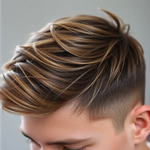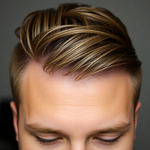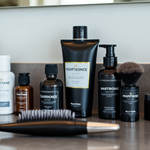
Semi-Permanent Hair Color: How Small Shade Tweaks Make Thrifted Pieces Shine in a Sustainable Men's Capsule Wardrobe
12 October 2025
Share
Intro — Struggle Less, Look Sharper
Struggling to look sharp without breaking the bank? Semi-Permanent Hair Color can be the secret weapon that elevates thrifted finds and makes a sustainable men's capsule wardrobe look intentional. In this guide you'll get practical shade pairings, step-by-step application, maintenance tips, and styling tricks to make small color tweaks deliver big style returns.
Semi-Permanent Hair Color: Why it fits a sustainable men's capsule wardrobe
Semi-permanent hair color deposits pigment without permanently altering your natural hair structure. That makes it ideal for men who shop secondhand, rotate a compact wardrobe, and want low-commitment ways to refresh their image. A well-chosen shade tweak coordinates with the tones of thrifted jackets, vintage tees, and classic denim — helping pieces look curated rather than random.
How a small shade tweak changes perception
Clothes and grooming interact. Here’s how a minor adjustment to hair tone shifts how viewers read your outfit:
- Warmth alignment: Warmer hair tones (golden, chestnut, copper) amplify tan, rust, and olive — making vintage suedes and corduroy feel cohesive.
- Contrast control: Cooler tones (ash brown, smokey) sharpen navy and charcoal, lending a more modern, minimalist edge.
- Depth and texture: Lowlights and subtle highlights add dimension so flatter fabrics (faded denim, washed tees) don’t appear washed-out.
- Intentionality: Even a five-minute root glaze signals upkeep and style awareness, which upgrades thrifted finds to staples.
Who should try semi-permanent hair color?
This approach works well for men aged 18–45 who want low-risk grooming with visible payoff. Consider it if you:
- Buy secondhand and want a cohesive look without buying new clothes.
- Prefer minimal upkeep — semi-permanent fades gradually and evenly.
- Want to test a shade change before committing to permanent dye.
- Care about sustainable choices and minimizing chemical exposure.
Choosing the right shade for your capsule palette
Start by auditing your closet. List the dominant colors and textures. Then match hair undertones to the most-visible part of your outfit (usually near your face).
- Neutral/minimal capsule (black, gray, navy): Go for cool ash-brown or soft espresso to keep the look streamlined and modern.
- Earth-toned capsule (olive, tan, rust): Warm chestnut or subtle golden undertones reinforce the palette and bring out fabric warmth.
- Vintage-heavy capsule (washed denim, faded tees): Add low-contrast highlights or soft copper to add life without clashing.
- Bold/colorful capsule: Keep hair one shade darker than the brightest piece and pick a neutralizing undertone (cool or warm) that balances the outfit.
Step-by-step: How to make a small shade tweak at home
Here’s a practical, safe routine to get visible results without overdoing it. Semi-permanent hair color: start small, build if needed.
- Do a mini-audit: Pick 3 standout pieces you wear most often. Note their closest face-level colors.
- Choose product wisely: Look for ammonia-free, low-PPD semi-permanent dyes or color-depositing conditioners. Brands with recyclable packaging and reduced chemical load are preferable.
- Strand and patch test: Always test for allergy and color result on a hidden strand. Follow the product’s patch-test timeline.
- Apply strategically: Apply color to roots and the top layer only if your goal is subtle depth. Leave the underside untreated to reduce product use and fade visibility.
- Start with minimum time: Set a timer for the shortest recommended development time (often 10–15 minutes). Rinse and evaluate in natural light.
- Adjust carefully: If the change is too subtle, incrementally increase development time on a second strand test rather than reapplying all over.
- Aftercare: Use sulfate-free, color-safe shampoo; condition regularly; rinse with cool water to keep pigment longer.
Product selection: what to look for and what to avoid
When shopping for semi-permanent products, prioritize low-impact formulas and practical packaging:
- Choose ammonia-free and peroxide-free if possible; these are gentler and better for repeated use.
- Prefer products labeled "deposit only" for subtle shading — they won’t lift natural pigment drastically.
- Avoid strong lifting agents or bleach at home; semi-permanent dyes won’t safely lift hair much anyway.
- Look for recyclable tubes or refill options to reduce waste.
Shade pairing cheat sheet for thrifted staples
Quick, practical pairings you can apply immediately:
- Tan leather jacket / suede: Warm chestnut or golden brown.
- Olive field jacket: Copper or soft warm brown to emphasize green tones.
- Navy blazer: Ash-brown or deep espresso for a crisp, professional feel.
- Gray wool coat: Neutral to cool brown; avoid strong warm reds that clash.
- Washed denim + vintage band tee: Subtle copper highlights for texture and brightness.
Upkeep and sustainability tips
Semi-permanent color can be a sustainable choice when you reduce waste and extend product life:
- Wash less often: shampoo 2–3 times a week and spot-clean as needed.
- Cold water rinses help color retention and waste less hot water energy.
- Use multi-use products: color-depositing conditioners combine conditioning and pigment in one step.
- Buy concentrated/refillable options when available to cut packaging waste.
Styling routines to maximize impact
Use grooming and outfit order to make shade tweaks read louder.
- Start with the hair: Style hair first so you can assess how it interacts with the outfit. A quick matte paste or light hold cream shows texture without shine that could wash out pigment.
- Layer thoughtfully: Put neutral layers closest to your face, then add statement thrifted pieces over them. The hair color will sit against the neutral foundation and tie the whole look together.
- Accessorize: Small metal tones (brass vs. silver) should match your hair warmth. Warm hair? Reach for brass hardware; cool hair? Lean silver.
Common mistakes and how to avoid them
- Too drastic too soon: Don’t attempt a dramatic lift with semi-permanent dye. If you want lighter hair, consult a pro.
- Ignoring undertones: Test whether your skin has warm or cool undertones before choosing a shade — this avoids clashes.
- Overusing product: Applying to all hair repeatedly wastes product and makes maintenance harder. Target the top layers and roots.
- Poor aftercare: Using harsh shampoos strips pigment quickly; choose color-safe formulas.
Case study: Mark’s thrifted blazer and the 20-minute tweak
Mark, a 32-year-old creative professional, found a near-perfect vintage tan blazer but felt his ashy light-brown hair flattened the outfit. He chose a warm chestnut semi-permanent glaze, applied only to roots and the top layer for 20 minutes, then rinsed with cool water. The blazer suddenly read as intentional — the outfit felt warmer and more cohesive. The glaze faded gradually over 6–8 weeks, and Mark repeated the process twice a year when refreshing his capsule for seasonal swaps.
Styling for different face shapes and hair types
Small shade tweaks interact with texture and silhouette. Here’s how to adapt:
- Thick hair: Use lower-contrast shades and add subtle highlights to reveal texture.
- Fine hair: Richer, slightly darker hues add perceived density and fullness.
- Curly hair: Target the top layer and avoid over-saturation; curls hold pigment differently than straight hair.
- Short cuts: Root-only application gives the biggest payoff with minimal product.
Semi-Permanent Hair Color and grooming synergy
Coordinate your grooming routine with color maintenance for a polished, low-effort daily routine:
- Two-minute scalp massage with sulfate-free shampoo to clean without stripping pigment.
- Color-depositing conditioner used once weekly to refresh tone.
- Apply a matte texturizer to style and avoid heavy oils that can dull color.
Where professional help makes sense
If you’re making a dramatic change, have a history of chemical treatments, or want precision (e.g., matching a very specific undertone), book a consultation with a colorist who understands semi-permanent options. A pro can create custom formulas that fade gracefully and complement your capsule's palette.
Resources and further reading
For safety information and guidance on hair coloring, see WebMD’s hair color basics: webmd.com — hair color basics. For sustainable grooming product choices, prioritize transparent ingredient lists and recyclable packaging.
Integrating Menll.com style values
At Menll.com we value sustainability, quality, and confidence. Small grooming moves should reflect those values — choose eco-conscious semi-permanent formulas and pair them with sustainable wardrobe picks. Menll.com’s EcoSneak Casual Shoes are an easy, everyday addition to a thrift-forward capsule that keeps comfort and low-impact manufacturing in mind. Browse Menll.com’s outerwear collection for jackets that pair especially well with warm chestnut and olive-toned tweaks: Menll.com outerwear.
Seasonal playbook: when to shift shades
Use the seasons as cues for subtle adjustments rather than full overhauls:
- Spring: Soft, slightly warm tones to brighten your face after winter.
- Summer: Subtle copper or golden hints that catch sunlight without fading too fast.
- Fall: Rich chestnut or deeper warm shades to match earth tones and layered textures.
- Winter: Cooler ash or espresso shades for crisp, minimalist looks.
Budget breakdown: cost vs. value
Doing semi-permanent color at home is often under $20–$40 per session with quality products; salon glazes run higher but offer more precision. Compared to buying new wardrobe items to update a look, a small color tweak is a cost-effective way to renew pieces you already own.
FAQ — Quick answers
- How long does semi-permanent color last? Usually 4–8 weeks depending on hair porosity and washing habits.
- Will it damage my hair? Most semi-permanent formulas are gentle, but cumulative product use without conditioning can dry hair. Use regular conditioning and occasional deep treatments.
- Can I go lighter? Semi-permanent dyes do not lift significant natural pigment. To go lighter you’ll need a professional approach.
- How often should I refresh? Every 6–8 weeks is typical for a steady appearance; color-depositing conditioners can refresh tone between applications.
Final thoughts and a simple challenge
Semi-Permanent Hair Color is a low-risk, high-reward tool for men who shop thrift and aim for a sustainable, considered capsule wardrobe. Small, intentional shade tweaks make thrifted pieces read like chosen staples instead of random finds. Try one subtle change this season — do a strand test, target the top layer, and pair the result with a favorite thrifted jacket. You might be surprised how much more confident you feel.
What's your go-to shade tweak or thrift find? Share it below — or browse Menll.com for sustainable additions to your capsule.

Prev post

Semi-Permanent Hair Color: A Two-Tone Shade Strategy to Double Looks from a Minimal Men's Capsule Wardrobe
Updated on 13 October 2025






